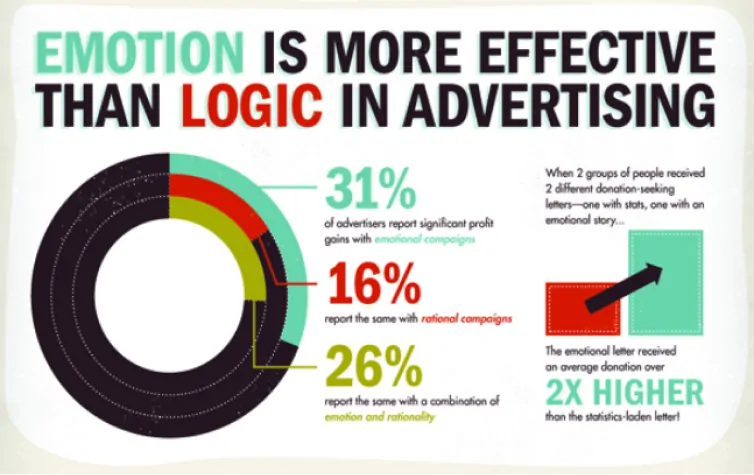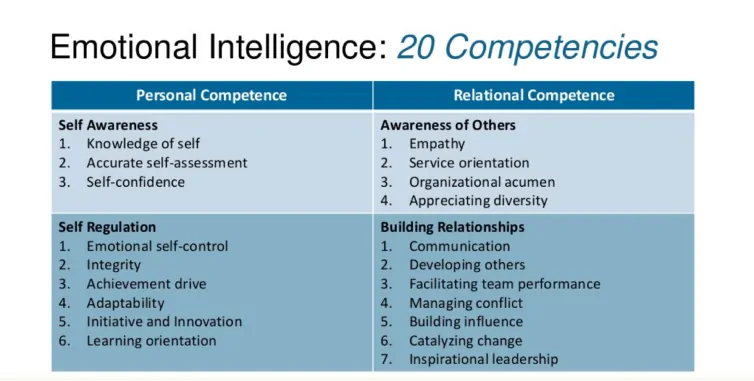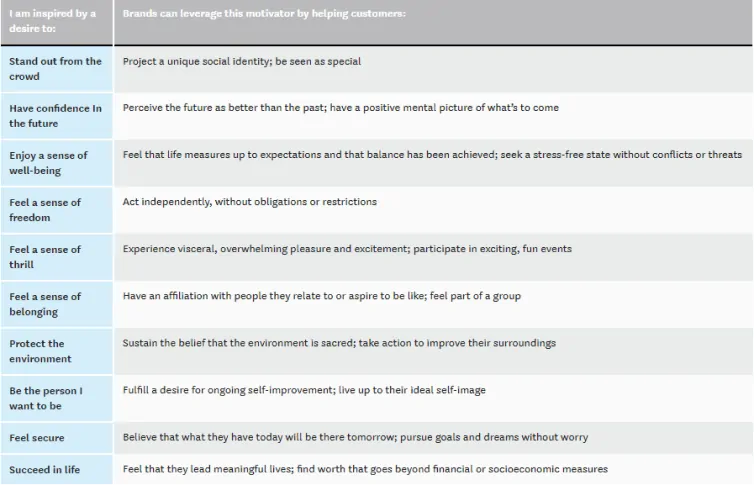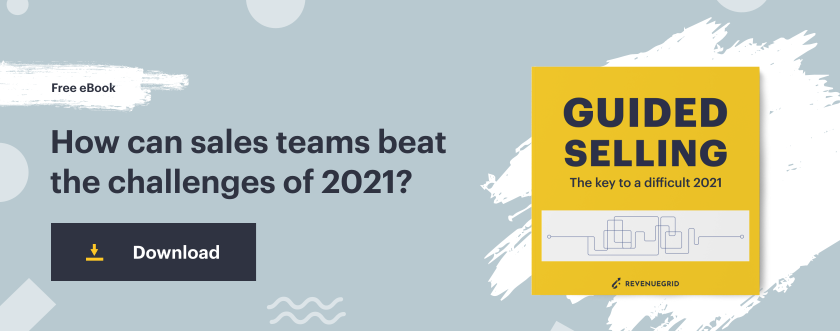There’s no crying in sales. Or, at least that’s what that thick-skinned sales rep stereotype might lead you to believe. It’s all about smooth pitching, sweet-talking, and closing at all costs.
Except, that’s not really the case.
Here’s the thing—emotions ABSOLUTELY sell. Today’s consumers want to feel seen. They want to deal with reps that understand them and listen to their hopes, dreams, and pain points.
Sure, a teary-eyed sales rep is enough to make any prospect feel, well, awkward. But, what we’re talking about here is how reps can use empathy and emotional triggers to tap into the feelings that motivate buyers.
In this article, we’ll look at how you can feel the emotion of the sale while guiding the prospect toward the close. Let’s dive in.
Emotions > logic. You just have to target the right one.
According to neuroscience, people tend to buy based on emotion, then justify their actions using logic.

While you shouldn’t dismiss rational decision-making entirely, you should definitely pay more attention to emotion in advertising.
While one could compare two versions of the same accounting tool by combing over spec sheets to determine the best value, the reality is, the buyer will likely choose the solution based on feelings—who told the best story? Which rep did they like more? Logic comes in later to function as a checks and balances system for buyers.
Because we’re feelings-first creatures, those reps that can find emotional opportunities in their data stand to get the best results.
The challenge, however, lies in understanding which specific emotions motivate your prospect. Is it fear? Envy? Shame?
Start by diving into your buyer personas, your various channels, and compiling information that you can use to piece together a psychological profile of your audience.
Try to answer the following questions as you run your research:
- Which pain points cause this segment the most, well, pain?
- Are there problems that come up over and over?
- What kinds of content does this group share on social media?
- What kind of tone is common with people in this group?
During your research, look for patterns that emerge by persona. Does one segment seem to place a high value on work-life balance or cut-throat competitiveness?
From there, you’ll want to gather some intel on specific prospects. Take to LinkedIn, existing CRM data, and review sites to piece together your emotional profiles.
Understanding the prospect’s role and where they work can help you develop a sense of what language to use, as well as what characteristics signal success in this industry. For instance, if you sell software to both startups and large financial firms, there’s a good chance that both segments will have a different set of emotional trigger points.
These details can help you figure out whether it makes more sense to emphasize convenience versus how your product is sure to impress the prospect’s boss.
Emotional essentials for salespeople.
As mentioned up top, the myth of the slick, sociopathic sales rep is dead. Today’s success stories come from those with a strong command of all things soft (skills)—which let’s face it, is our one advantage over robots.
Emotional sales techniques don’t stop at the buyer–salespeople need to level up their EQ (emotional intelligence), too.

Do your salespeople possess the following emotional intelligence skills?
Though emotional intelligence covers a wide range of soft skills, here are a few areas that demand a little extra attention.
Empathy
Empathy is an interesting area. We all think we have it, but in reality, few of us can effectively step into someone’s shoes. In sales, you’ll want to make sure you connect the customer experience to their emotions and their big-picture goals. This means playing consultant—listening to what people say and connecting internally, developing your emotional intelligence goes beyond making sure that you approach prospects with empathy.
Self-Regulation
Self-regulation is the ability to control your own feelings and impulses to avoid passing on your negativity to your prospect. The idea is to eliminate negative emotional responses to feedback—creating resilience among reps, as they’re in a position where too many “nos” combined with a long list of notes on their sales call can feel demoralizing.
Assertiveness and Resilience
Salesforce interviewed Steven Stein and Howard Book, co-authors of The EQ Edge. Stein and Book recommend that sales leaders work with reps to develop assertiveness, self-regard, and what they call a “raise your hand culture.”
What they mean by “raise your hand culture” is, an environment where people own up to mistakes and treat them as learning opportunities. The emphasis is on progress and growth, rather than a culture of shame or covering up mistakes.
Give yourself an emotional audit
Think that feeling the emotion of the sale is just about understanding the customer and pulling their emotional triggers? That sounds more like manipulation to us.
Low emotional intelligence means trouble for your sales performance because people don’t want to do business with someone they don’t like
Get your emotions in check by giving yourself a check-up. Here are a couple of places to start:
Listen to your sales calls
If prospects seem to be falling out of the sales funnel, you might have an “emotions problem.” Listen to a few sales calls and score them based on these points:
- Goal—Sales calls should focus on one goal, which depends on who you’re talking to and where they are in the buying process.
- Assertiveness—Did you get influenced by the prospect or stay in control of the conversation? How did you handle objections? Were you flustered? Or, were you prepared with an answer?
- Active listening—Did you interrupt the prospect? Did you talk more than you listened?
- Rapport—What’s the back and forth like? Were you able to connect with the prospect or did it feel awkward?
While it’s painful for most of us to listen to calls, you can’t improve what you don’t track.
Listen for moments where your emotional triggers cause a reaction–are there moments where you’ve failed to hide your irritation? Do you sound frustrated when someone says no?
On the flip side, you’ll also want to make sure that your empathy doesn’t turn you into a pushover. Don’t be afraid to ask questions about who the decision-makers are or what kind of budget they’re working with.
Review your emails
You’ll also want to look at your sales emails. Check out the design, copy, calls-to-action, and of course, the headline to get a sense of the emotion your message conveys.
Here are some questions to keep in mind as you review your written communications.
- What kind of response do people have to the content?
- Are you using emotional trigger words?
- Are you telling a story, painting a picture, or provoking an emotional response some other way?
- Is your message centered around one idea/feeling?
- Have you made sure to personalize the email to this specific person?
How can you tap into your emotions to make more sales?
According to the Harvard Business Review, customers who have an emotional connection to a product or brand bring about 52% more value to those brands than customers who don’t feel that “spark.”
The HBR offers up a 10-point list of “high-impact motivators” that you can tap into by helping this person do X.

Salespeople have many motivators. Smart brands can leverage these to connect with customers.
Identify Motivators by Asking the Right Questions
Ideally, your qualifying questions will reveal more about your prospect than whether or not they’re willing and able to buy.
It’s about identifying pain points—and on top of that, scanning for signs that can let you know which emotional triggers are most effective for this individual.
- What are your biggest challenges?
- What hurdles might get in the way of this project?
- Have you tried to solve this problem in the past?
- How long have you been thinking about making this purchase?
- What do you hope to gain from this call?
- Where do you see yourself six months from now?
During an initial conversation, these questions can help you identify some emotional buzzwords you can use when you follow up.
Triggers to pull on the emotional buying journey
Every phone call, email, chat, or whatever, should generate some type of emotional response. Your research and discovery questions can help you nail down how you approach your prospect. As mentioned in the last section, look out for concerns and specific words that indicate an underlying motivator.
A few angles you might explore, here:
Trust
Use this when someone values control. They care about feeling safe, secure, and that they’re working with the kind of brand that is reputable, reliable, and won’t surprise them with any hidden fees.
- Paint a picture of what your product does. Here, your goal is to make this person understand how you can help them improve their business.
- Put your best trust signals on display. Now is the time to show prospects your accolades. Highlight any noted credentials, showcase your five-star reviews, media mentions, and high-profile clients.
- Share knowledge and statistics with your prospects. Original research, case studies, reports–consider where you can provide some assurance by offering valuable content that both helps this person–and proves that you know what you’re talking about.
- Here, you’ll want to use words like reliable, results, trusted, and secure to build trust. Keep in mind, however, this person expects you to make good on your claims—so don’t make promises you can’t keep.
Greed
Where some are motivated by convenience or power, others are driven by their desire to improve or achieve. If you’ve got a prospect like this on your hands, apply the following ideas to your sales pitch.
- Bring up success stories. If you have customers that have achieved specific results using your service, let the prospect know–this type of social proof is especially useful if you have customers that have been featured in a news story or are respected in their field.
- If possible, offer some publicity. To this prospect, the public-facing image is a big deal–if there’s an opportunity to feature the prospect in a case study, let them know.
- Use words like reputation, influence, and image to tap into your prospect’s psyche–in other words, how will your product help them succeed.
Pleasure
People not only want to avoid pain; they’re also motivated by things that make them feel good. Shocking, right?!
- How does your offering deliver a positive experience to customers? Are the benefits direct or indirect?
- How does your product delight users?
- Paint a picture of a better situation. Consider how they’ll have more fun if they buy X thing or they won’t have to do X anymore if they use the right software.
- Here, use words like imagine, opportunity, enjoy, or satisfy to paint a picture of a brighter future.
Convenience
Convenience oriented folks want solutions that can save them time. In this case, you’ll push their trigger points by emphasizing how your product can automate manual tasks—freeing up time for more meaningful work. You might also bring up points about how easy it is to get up and running with your company.
- Explain value in terms of time lost—What are the long-term consequences of failing to find a better solution? How much time does this person lose by keeping the same solution in place?
- Show them how they could be spending their time instead. Does your solution give them more time to spend with family? Does it eliminate manual data entry? If this person can get this one area under control, what will that do for them?
- Pull the lever using words like simple, productivity, fast, easy, effective, to play into their desire to work smarter.
Plan for objections.
Consider the objections your prospects would respond with and utilize them in your messaging.
Why is your solution worth the investment? Consider how long the prospect has had the same problem. If you’re talking to someone motivated by pleasure, paint a picture of how their life could be better if it weren’t for that looming pain point standing in the way.
What you’ll also want to do here is get your prospect talking. When faced with an objection, ask “what’s holding you back?” to get buyers to share the reason behind their reservations.
From there, your EQ will serve you well. Your job is to listen to their concerns and reframe the conversation to help them understand how your product/service will help them overcome challenges.
Technology helps reps go beyond emotions.
In this relationship era, selling is about guiding people’s emotions toward completing the journey. Our CRMs and engagement tools are loaded with actionable insights–which means, feeling the emotion of the sale isn’t just about gut feelings–it’s about data.
RevenueGrid’s tracks marketing and sales outcomes from the first conversation to the close and beyond. This way, teams know exactly which emotional selling techniques deliver the most reliable results. Book a demo and see for yourself.

